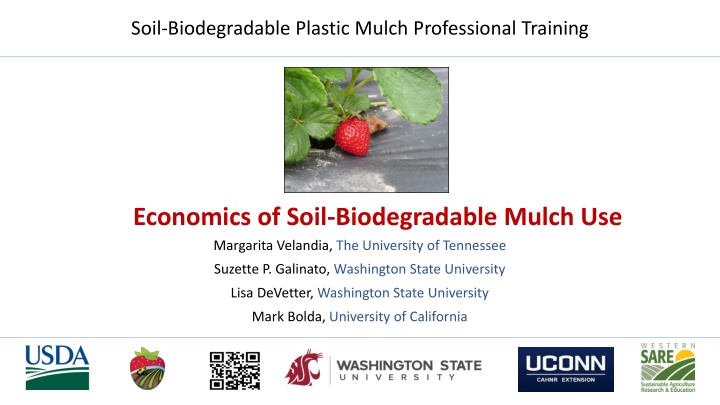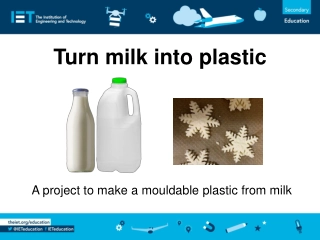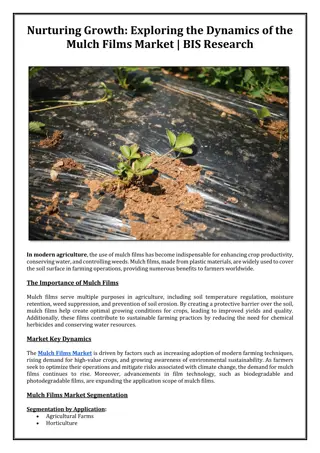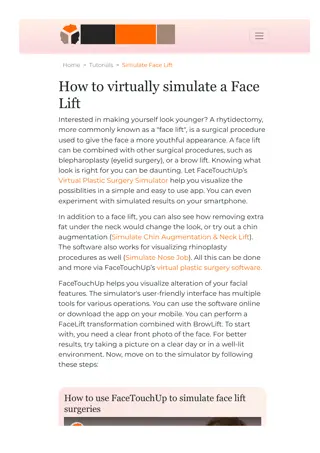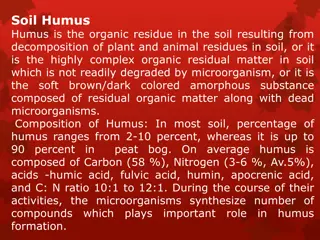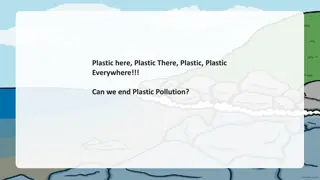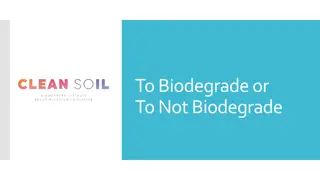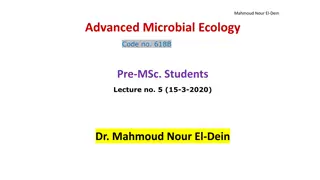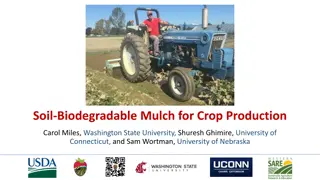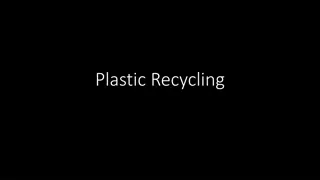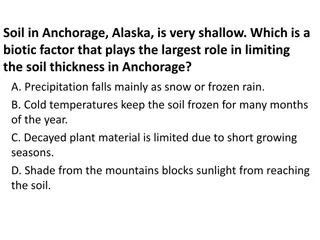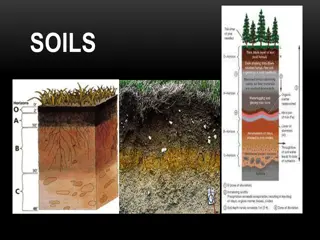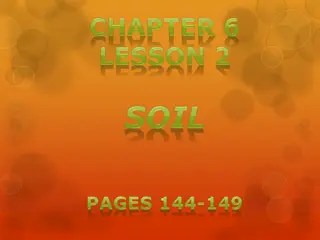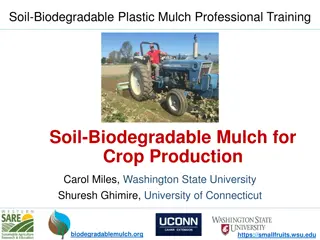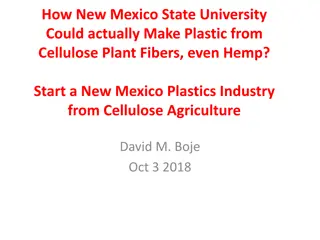Economic Considerations for Soil-Biodegradable Plastic Mulch Adoption in Agriculture
Economic considerations play a crucial role in adopting new technologies like soil-biodegradable plastic mulch in agriculture. This training provides insights into the costs, benefits, and overall profitability of using biodegradable mulch compared to traditional practices. It covers aspects such as initial purchase costs, material use, labor requirements, and disposal expenses, highlighting the factors that influence decision-making for farmers. Understanding the economics of adopting sustainable practices can help improve production efficiency, reduce environmental impact, and enhance profitability in agricultural operations.
Download Presentation

Please find below an Image/Link to download the presentation.
The content on the website is provided AS IS for your information and personal use only. It may not be sold, licensed, or shared on other websites without obtaining consent from the author.If you encounter any issues during the download, it is possible that the publisher has removed the file from their server.
You are allowed to download the files provided on this website for personal or commercial use, subject to the condition that they are used lawfully. All files are the property of their respective owners.
The content on the website is provided AS IS for your information and personal use only. It may not be sold, licensed, or shared on other websites without obtaining consent from the author.
E N D
Presentation Transcript
Soil-Biodegradable Plastic Mulch Professional Training Economics of Soil-Biodegradable Mulch Use Margarita Velandia, The University of Tennessee Suzette P. Galinato, Washington State University Lisa DeVetter, Washington State University Mark Bolda, University of California
Overall Economic Considerations Why adopt a new practice or new technology in agriculture? Examples: To improve production efficiency and crop yield To reduce environmental footprint To increase the profitability of production activity What are the general economic considerations to adopt a new agricultural technology relative to standard practice? Costs cost of the technology (material, labor) Benefits reduced input costs, improved crop yield, etc. Net profit = Revenue minus Costs if positive, keeps the farm in business Tech adoption costs, other variable costs and fixed costs Output Price x Yield Net profitTechnology adoption > Net profitStandard practice
Initial Purchase Costs BDM vs PE Do BDMs cost more than PE mulches? Plastic BDMs PE mulch Paper BDMs Roll Dimensions (ft) 4 x 4,000 4 x 4,000 4 x 1,000 Roll thickness (mil) 0.6 1.0 9.0 Purchase cost (without input supplier discount or shipping cost)* $270-$360 $128-$325 $300 Machine application Yes Yes Yes * Shipping cost can increase the base price significantly if local suppliers do not carry BDMs
Costs of PE Mulch Use Material cost Cost to remove PE mulches at the end of the season Labor hours to remove PE mulch Cost of labor Amount of plastic to be removed Cost to dispose PE mulch at the end of the season Labor cost Transportation cost Landfill disposal fees Examples as of 2022: $31 to $54 per ton in TN, $40.13-$81 per ton in CA, $56-$144 per ton in WA; National average is about $58 per ton. Some counties do not accept PE mulch for disposal
Economic Considerations for BDMs Not all end-of-season activities related to handling of mulch will be eliminated when adopting plastic BDMs Same as with PE mulch, drip tape must be removed before tilling BDMs into the soil Based on 1 on-farm trial with pepper, drip tape removal required 1.6 2.4 person-hours per acre with 6-ft row spacing. Estimates may vary due to soil, environmental conditions, and other factors Tilling BDMs into the soil will involve operator labor (this operation may not be an additional cost if tillage is one of typical field activities done at the end of the growing season) Rototilling BDM and crop debris into the field at the end of the crop season.
Economic Analysis Changes Associated with Adopting BDM (Baseline: PE Mulch Use) Additional Costs (AC): BDMs are more expensive than PE mulch Tilling BDMs in the soil: operator labor; assume tilling the soil is a typical end-of-season activity, therefore no additional tillage cost Additional Income (AI): Changes in yield? Changes in prices? Are consumers willing to pay a premium for products grown with BDMs? Current assumption: No changes in prices and yields Reduced Income (RI): Current assumption: No changes in prices and yield due to BDMs adoption Reduced Costs(RC): Labor reduced labor associated with end of season activities No disposal cost (e.g., transportation, disposal fee) A. Total AC and RI B. Total AI and RC Net Change in Profit (B-A)
Economic Analysis Assumptions: Thickness of PE mulch: 1.0 mil Thickness of BDM: 0.6 mil Mulch roll size: 4 ft x 4,000 ft Bed spacing: 6 ft Removal and disposal: 17.25 hours/acre No. of mulch rolls per acre: 2 Cost PE mulch/acre: 2 x $220/roll = $440/acre Cost BDM/acre: 2 x $315/roll = $630/acre Labor Cost: $17.20/hour Disposal cost: $61/ton (estimated U.S. average) Drip tape removal: 1.5 hours/acre Changes Associated with Adopting BDM Additional Cost (AC): $190.00 BDM material cost: Additional Income (AI): $0 Current assumption: No changes in prices and yields. $190.00 Reduced Income (RI): $0 Current assumption: no changes in prices and yield due to BDMs adoption Reduced Costs(RC): $278.83 Labor savings: $270.90 Disposal savings: $7.93 A. Total AC and RI: $190.00 B. Total AI and RC: $278.83 Net Change in Profit (B-A): $88.83
Sensitivity Analysis: BDM cost $200 Net Profit BDM Net Profit PE mulch $150 $100 At $359/roll, ($/acre) Net ProfitBDM = Net ProfitPE $50 $0 $265 $290 $315 $340 $365 $390 -$50 -$100 Price of 4 ft x 4,000 ft roll of BDM
Sensitivity Analysis: Labor hours $300 Net Profit BDM Net Profit PE mulch $250 $200 $150 ($/acre) At about 12 hours/acre, Net ProfitBDM = Net ProfitPE $100 $50 $0 7.25 12.25 17.25 22.25 27.25 -$50 -$100 Labor hours for removal and disposal of PE mulch (hours/acre)
Sensitivity Analysis: Labor rate $150 Net Profit BDM Net Profit PE mulch $100 At $11.60/ hour, Net ProfitBDM = Net ProfitPE ($/acre) $50 $0 $14.53 $16.98 $17.20 $19.75 Labor rate ($/hour)
Other Notes about Labor The farm owner is often responsible for performing cleanup activities at the end of the season Owner s hours often not considered a direct cash expense; may be overlooked This unpaid labor must be calculated and included in the production costs Implications for farms employing migrant workers If labor hours are reduced during end-of-season activities, laborers may transfer to another farm who can employ them for longer hours
Tool - Mulch Calculator Interactive Mulch Calculator assists farmers to determine the quantity of much needed and provides cost comparison to PE mulch Available (for free) see Resources Two components: 1. Image: D. Low, 2014 Requirement Calculator - how many rolls of mulch (per acre or per hectare) need to be purchased based on roll length and spacing between bed centers Cost Calculator machinery cost, material cost, as well as the cost of labor to install the mulch, costs associated with clean- up activities 2. Chen et al., 2018
Tool - Mulch Calculator Assumptions 1. Required machinery and number of person-hours to install PE mulch and BDM are the same 2. In Cost Calculator example, PE mulch removal is by hand (machinery cost would need to be added) 3. Drip tape is removed simultaneously with PE mulch and 1.5 hours per acre is used for cost of removing Image: D. Low, 2014 drip tape before BDM is tilled into soil (this number can be adjusted as needed) 4. PE mulch is disposed in landfill for fee, while BDM is tilled into soil (thereby eliminating removal and disposal costs) 5. Usually takes 3 hours per acre to till BDM into soil based on field study in WA, but largely depends on type of equipment used (this number can be modified if needed)
Key Takeaways Clear benefits of BDM: elimination of removal and disposal costs associated with PE mulch BDM is potentially a more profitable alternative than PE mulch given one or a combination of the following: Low to moderate material cost of BDM, High labor requirement to remove and dispose PE mulch, and High farm labor rates Critical factors to assess the economic feasibility of BDM: Costs material and labor If growers focus only on costs, they will be unable to take advantage of opportunities or benefits that can improve their net profit. So must also consider: Benefits cost savings, etc. Positive Net Profit most important to stay in business; compare with net profit when using PE mulch
Resources Adverse effect wage rate 2024 https://flag.dol.gov/wage-data/adverse-effect-wage-rates Municipal Solid Waste Landfill Tipping Fee Environmental Research and Education Foundation. 2023. Analysis of MSW Landfill Tipping Fees 2022. https://erefdn.org/2022-msw-landfill-tipping-fees/ https://www.wastetodaymagazine.com/news/eref-study-shows-msw-landfill-tip-fees-rose- sharply-in-2022/ Mulch Calculator Chen-Mulch-calculcator-introduction.pdf (tennessee.edu) The Economics of Adopting Biodegradable Plastic Mulch Films Velandia-et-al-The-Economics-of-Adopting-Biodegradable-Mulch.pdf (tennessee.edu)
Resources The Economic Feasibility of Adopting Plastic Biodegradable Mulches in Pumpkin Production https://biodegradablemulch.tennessee.edu/wp-content/uploads/sites/214/2020/12/W822.pdf https://pubs.extension.wsu.edu/economic-feasibility-of-using-alternative-plastic-mulches-a- pumpkin-case-study-in-western-washington Dimensions and Costs of Biodegradable Plastic and Polyethylene Mulches (raspberry emphasis) https://s3.wp.wsu.edu/uploads/sites/2181/2017/06/FactSheet.CostandDimensions-2.pdf Important Considerations for the Use of BDM in Crop Production https://research.libraries.wsu.edu/xmlui/handle/2376/13104 Information and materials for use of mulches in small fruit production https://smallfruits.wsu.edu/plastic-mulches/ Basic information sources, frequently asked questions, videos, and publications BDM project website: https://www.biodegradablemulch.org
